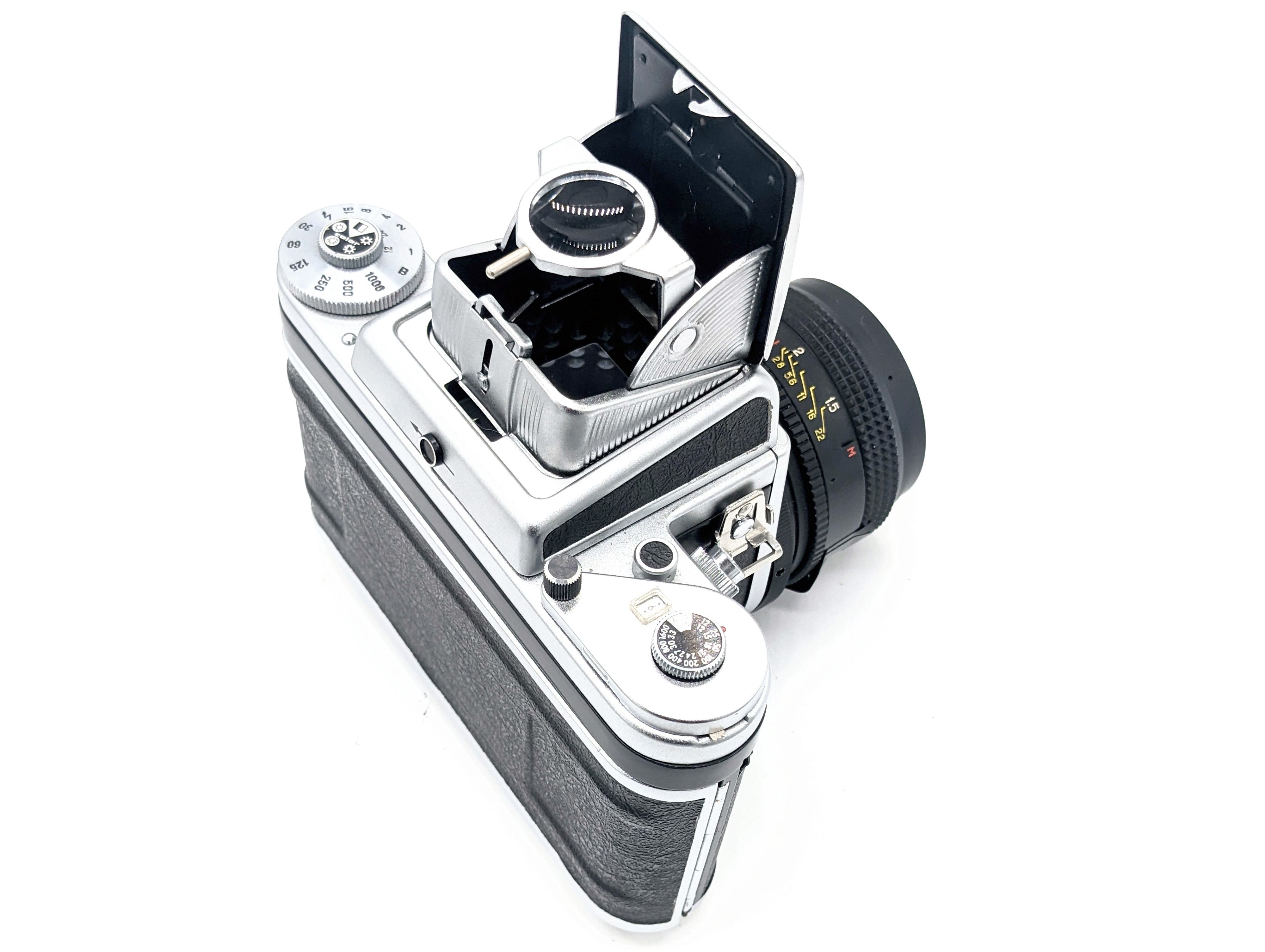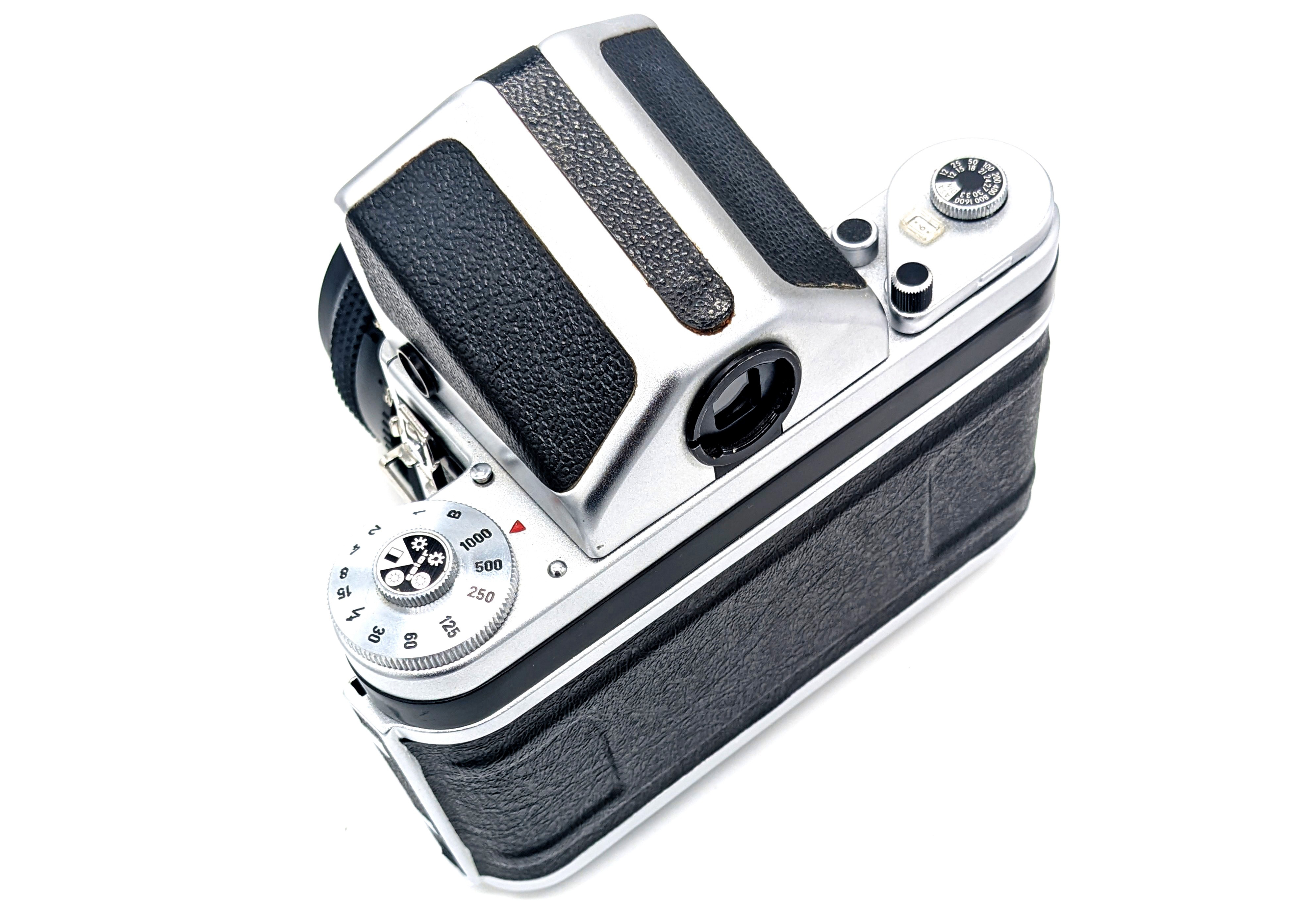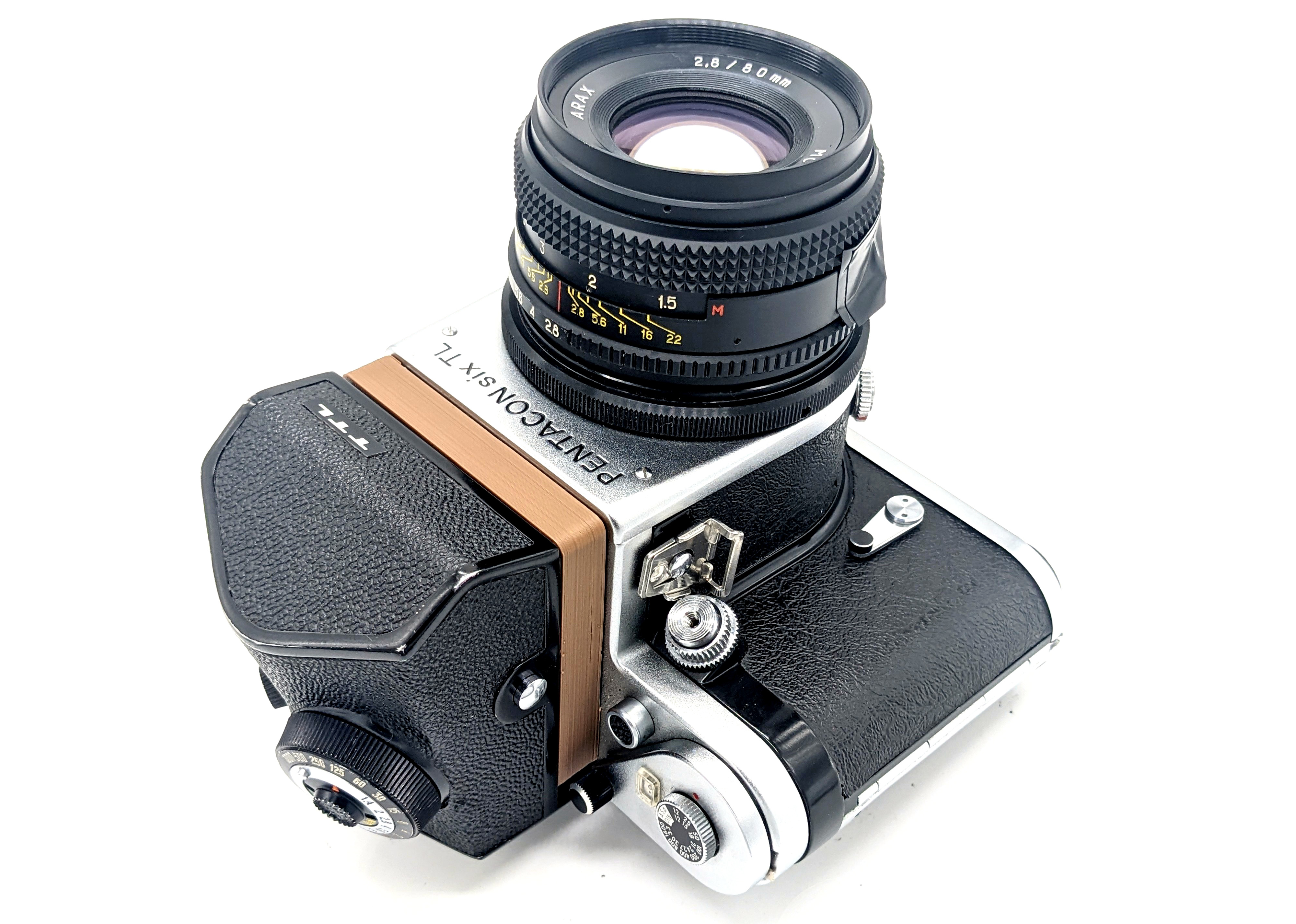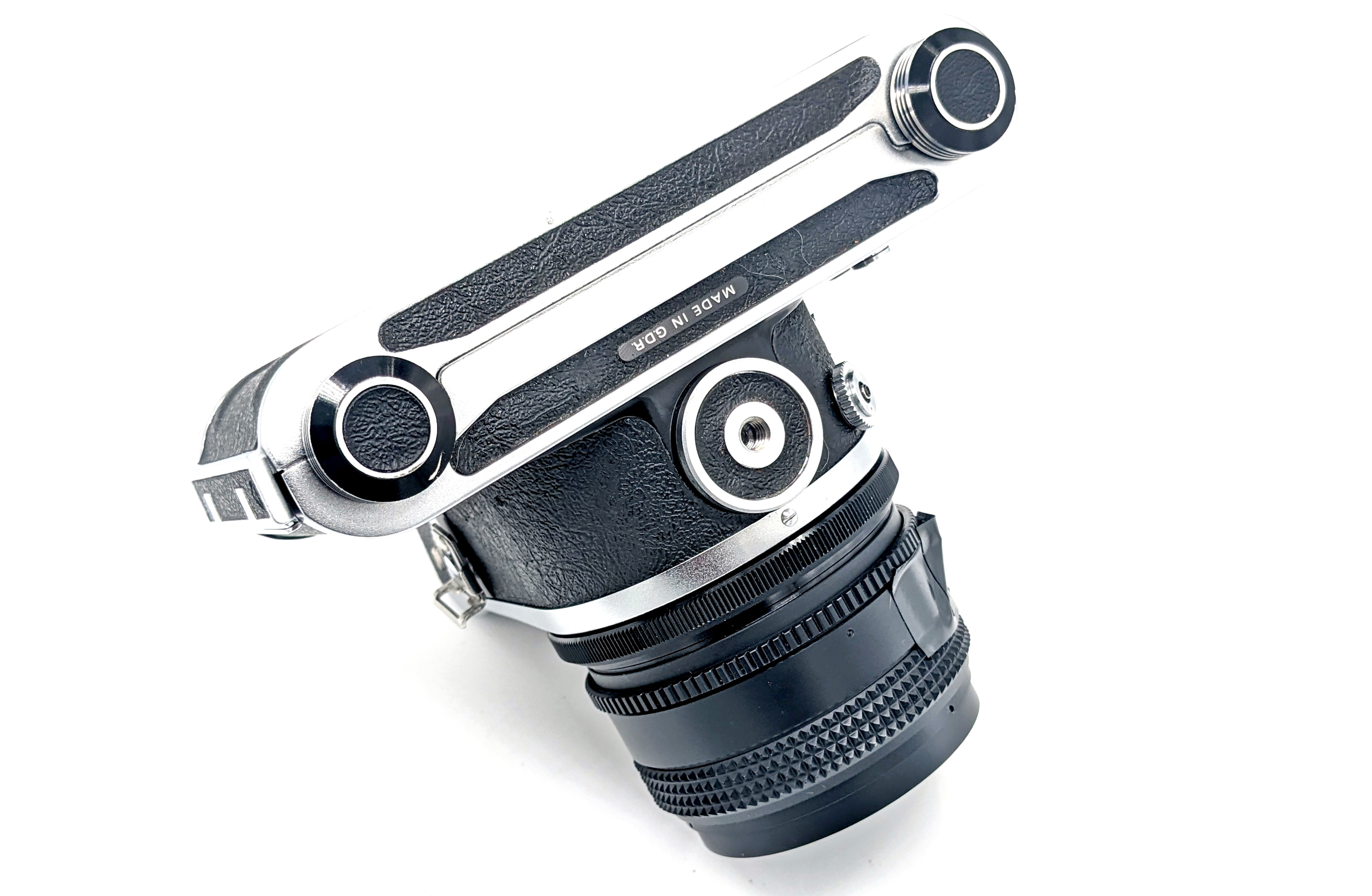
Introduced in 1966, the East German Pentacon Six is an SLR-style 6×6, interchangeable-lens medium format camera. With its essential architecture dating back to 1956, the P6 operates essentially as a “grown-up” version of a Praktina 35mm SLR from the same era. While arguably not what we would consider today as a “professional” system, lacking the expected range of accessories, the P6 was a successful product with many working examples floating around the world today. Being a fairly cheap camera with a good selection of 1950s-1990s German and Ukrainian lenses, is the P6 a good option for the world of 6×6 photography? For sure.
As with many other famous East German camera products, the concept of a single-lens reflex, interchangeable-lens 6×6 camera finds its origin before WWII. In 1935, a Dresden-based company named “Korelle-Werk” produced the “Reflex-Korelle,” perhaps the first 6×6 reflex-view cameras. After the war, the 1950 “Meister-Korelle” (called the “Master Reflex” in the USA) featured interchangeable lenses, a focal plane shutter, shutter speeds from 1-1/1000. The Meister-Korelle was discontinued in 1952.
Introduced at Photokina in 1956 and then to market in 1957, the “Praktisix” was a further evolution of the Meister-Korelle concept and formed the essential basis of the later P6. Produced by Kamera-Werkstatten in Dresden, perhaps most famous for its “Praktina” line of 35mm SLRs, the Praktisix was well-regarded, being produced until it was replaced by the P6. It does not appear that the Praktisix was exported in any meaningful quantity to North America until about 1962. In America, the Praktisix was fairly cheap, being advertised during 1962-63 for around $150 with its standard waist-level finder and an 80mm f/2.8 Carl Zeiss Jena lens.
During 1964, the East German camera industry consolidated further, forming the company “VEB Pentacon.” After this consolidation, Pentacon made a few tweaks to the Praktisix and introduced the “Pentacon Six ” in 1966. The notable upgrades over the last version of the Praktisix included improvement to the film transport system, the ability to use 220 film, and an automatic film counter reset. In 1968, Pentacon introduced the P6 “TL,” which coincided with the introduction of an uncoupled metered prism. It appears that the P6 with its Carl Zeiss Jena 80mm f/2.8 Biometar hit the North American market in 1968. Advertised during the early 1970s with a standard lens and case often for around $199 or less, the P6 was certainly one of the cheapest 6×6 interchangeable-lens medium format systems on the market. The P6 was also sold under the name “Haminex Praktica 66.” It is not clear how long the P6 was sold “new” in North America, but advertisements for new copies seem to have stopped around 1972. For whatever reason, at some point during the early 1970s, further new East German camera products seem to have largely disappeared from the American market.
The P6 eventually spawned three spinoffs. In 1971, Arsenal (Ukraine) introduced the “Kiev 6C,” a 6×6 camera with similar proportions, capabilities, and the same lens mount. This model was followed in 1984 by an improved, yet often-unreliable “Kiev 60.” Until very recently, a Ukrainian company called “Arax Foto” offered rebuilt and upgraded Kiev 60s and a company called Hartblei still does. The final spinoff was the “Exakta 66,” a somewhat-unreliable higher-tech 1986 West German version of the P6 that offered a number of very high quality lenses made by Schneider Kreuznach. A wonderful site to peruse regarding all things P6 is here.
Building a Pentacon Six TL
The first thing you may want to do with a P6 is build it to your preferences. Needless to say, to get the most out of the system, a stock P6 may need a little work.

Finders/Prisms
Pentacon offered three main options for finders/prisms for the P6: (1) a waist-level viewfinder; (2) a nonmetered prism; and (3) a metered prism. With the once-available aftermarket metal adapters now unavailable, the P6 could also easily use finders/prisms made for the Kiev 60 system. As of 2023, unless you can find one of the older adapters second-hand, your best bet will be to 3D print your own, like this one.
The first fork in the road is whether you prefer using the P6 like a TLR (looking down) or an SLR (a level view). Remember that the waist-level finder will present the image reversed horizontally. If taking the TLR approach, the standard waist-level finder should be fine. If you are seeking a better option, the waist-level finder for the Kiev 60 is better (with an adapter).
For prism finders, there is no question that an adapted Kiev 60 TTL metered prism is the best option. It is not only brighter than both P6 prisms but has greater coverage of the focusing screen. With an appropriate battery stack adapter, the Kiev 60 prism can be powered by three common SR44 batteries. Aftermarket focusing screens tend to throw the Kiev’s metering off, so you may have to set the maximum aperture on the prism to some point on the dial below “1.4” to get correct readings. By contrast, the native P6 prisms are a little dark and do not have full viewfinder overage. The P6 TTL prism also uses discontinued 1.35V mercury batteries, and does not cover the entirety of the focusing screen. While high-quality metal plug-and-play Kiev-to-P6 prism adapters formerly existed, they are now discontinued. Someone really should consider licensing the design from Baier Fototechnik and start making them again. Otherwise, 3-D printing is the only option for now.

Focusing Screens
After choosing a preferred viewfinder/prism, the next step is whether you want to upgrade the stock focusing screen. Despite some reports, the stock, ground-glass, focusing screen is bright enough when using a f/2.8 lens in daylight conditions. However, it is not so nice in lower light or with slower lenses.
With the original P6 screens being a little difficult to find these days. there are a few relatively-inexpensive aftermarket options, including those with a traditional SLR-style split-screen focusing aid and/or microprism collar. Current options include: (1) a screen made for the P6 by Arsenal in the Ukraine; and (2) screens made in China found on eBay. The Arsenal and Chinese screens are made out of optical plastic, rather than glass. Replacing the screen will make using the P6 far more pleasant.
It must be noted that the modern aftermarket replacement screens are far, far thinner than the original curved / thick Pentacon screens. So thin, in fact, that you cannot really re-use the original retaining wire (which were “bent” to conform to the curved shape of the OG P6 screens) and the clips are not deep enough to even anchor the retaining wire even if you could make it work. Fortunately, an aftermarket thin screen can normally work just by “sitting” in place without additional securing. Just make sure after you install an aftermarket screen that the camera is focusing perfectly at infinity.

Standard Lens
If new to the system, it is probably a good idea to start off with a lens in the 80mm-90mm focal length, which translates to about 45mm-55mm in the 35mm format. Most of the standard lenses are fairly easy to find and affordable. These are the most common ones.
Carl Zeiss Jena 80mm f/2.8 Biometar: The Biometar was the standard lens offered with P6 models. These come in two flavors: a single-coated “zebra” edition and a later multicoated version. If your P6 came with one of these, you are all set. However, priced apart from a P6 body, standalone Biometars, especially the later multicoated versions, are getting a little spendy.
Vega-12B 90mm f/2.8: The Vega-12B was the standard lens for the Kiev 6 and Salyut-S 6×6 cameras, made at the Arsenal plant until the early 1980s. A single-coated optic, the 90mm focal length is arguably a bit better for portrait photography. Some folks prefer the rendering of the Vega to the Biometar.
Volna-3 80mm f/2.8: The Volna-3 replaced the Vega-12B as the standard lens for Kiev 60 cameras. The Volna-3 can also be found with “Arsat” branding. Where the earlier versions were single-coated optics, the later examples were multicoated. A somewhat frustrating design flaw with the Volna-3 is that the aperture stop-down lever on the side of the lens often creates a light leak at its minimum focusing distances. You could just put some black electrical tape over the lever. Unlike the P6, taping over the stop down lever is not such a big deal for the Kiev 60 because it has an independent DOF preview lever on the body.
Arax 80mm f/2.8: This Arax Foto product is the same lens as the the Volna-3, but checked, cleaned, and upgraded. Currently, you can order these any day from Arax’s site with either a metal or rubber focusing ring. If you are looking for a standard lens, want a lens that someone has already looked over, and do not want the hassle of attempting to find a good one second-hand, I would suggest going this route. It does have the same “light leak through the stop-down lever” as the Volna-3.
The design of the Biometar is derived from the old Xenotar template. The Vega-12B shares a similar design to the Biometar. The Volna-3 resembles neither and is a more traditional “50mm SLR” lens design. What is better about the Ukrainian lenses is that they focus much more closely than the Biometar. With either the Vega-12 or Volna-3, remember that they were also produced for the Kiev 88 cameras, whose lenses are not compatible with the P6. These lenses are supposed to be distinguished by letter, with “B” meaning P6 mount and “V” meaning Kiev 88 mount. Watch out as some internet sellers sometimes confuse the two.
Here are the specs of the three primary lenses compared.
| Lens | Biometar 80mm f/2.8 | Vega-12B 90mm f/2.8 | Volna-3 80mm f/2.8 |
| Manufacturer | Carl Zeiss Jena | Arsenal | Arsenal |
| Year Introduced | @ 1956 (SC); @ mid-1970s (MC) | @ 1971 | @ 1984 |
| Design | 5 Elements, 4 Groups | 5 Elements, 4 Groups | 6 Elements, 5 Groups |
| Min. Focus | 1.00m | 0.6m | 0.6m |
| Weight | 260g | 480g | 420g |
| Coating | Multicoated | Single | Multicoated |
| Filter Size | 58mm | 58mm | 62mm |
| Aperture Blades | 8 | 6 | 6 |
There are also the older 1950s CZJ 80mm f/2.8 Tessar (one of the standard lenses for the earlier Praktisix) and a high-performing / expensive Schneider Kreuznach 80mm f/2.8 (produced for the later Exakta 66). If you are into something slightly wider, there are the 1960s CZJ 65mm f/2.8 Flektogon (quite rare today in decent condition), the 1970s Arsenal Mir-3B 65mm f/3.5 (reportedly an excellent, but hefty, optic), or the 1980s multicoated Arsenal Mir-38B 65mm f/3.5 (opinions vary). Whatever is clever.

Functionality
The P6 operates more or less like an 1950s SLR. There are really only two major and two minor shortcomings with the system that may or may not matter to you.
The first major issue is that there is no depth-of-field preview lever as CZJ lenses made for the system had DOF levers built-in. The second major issue there is no native mirror lock-up function, which prevents using lower shutter speeds to prevent shake.
The first minor issue (that is endemic to medium format focal plane shutter cameras), is that the X flash sync is a paltry 1/25, which effectively prevents reliable handheld electronic flash shots. The second minor issue is that there is no accessory shoe on the camera. Pentacon only offered an add-on accessory shoe that fit on its prism viewfinders.
Open Aperture Focusing: The P6 holds the aperture wide open for the purposes of framing and focusing. This is accomplished by a pin of the lens interacting with the camera body. With f/2.8 lenses and waist-level finder, the stock groundglass focusing screen is bright enough for everyday use. However, upgrading to a brighter screen that has some kind of focusing aid will make your life easier.
Focal Plane Shutter: The P6’s focal plane shutter has two separate curtains. The shutter and mirror flip noise is not as loud as you think it would be and sounds quite elegant. Advancing the film resets the mirror position and cocks the shutter for the next shot.
Weight: Although the P6 can be appear to be quite large, its stock set-up (waist level finder + 80mm lens) does not feel heavy or particularly bulky. Indeed, CZJ seems to have prioritized making its 50/65/80/120 line-up as light as possible. It is only when bolting on prisms and using the heavier and physically larger Ukrainian lenses that a P6 begins to weigh you down a bit.
Shutter Speeds: The shutter speed dial has discrete clicked positions for each speed from B to 1/1000. The speeds can be set whether the shutter is cocked or not.
120/220 Film: An upgrade over the Praktisix, the P6 can use both 120 and 220 films. No special operation is required other than releasing a lock that permits the film advance to go past 12 frames.
Loading the Film: A much discussed topic is the P6’s inability to tolerate sloppy film loading. For those familiar with medium format systems, this issue is not necessarily unique to the P6. When loading the film, make sure that the film is tight as possible as it advances (it may take more than one try to accomplish this). Also, be sure when advancing the film / cocking the shutter to ease the lever back rather than letting it “snap back.” Even if you are careful with loading and advancing, irregular frame spacing can occur. However, as long as the frames do not actually overlap or touch each other, it will be fine.
Standard Cable Release: The P6 uses a standard screw-in cable release, very useful for using the camera on a tripod or with a handle.
Camera Strap: Like many cameras, the P6’s case doubled as its camera strap. If you do not have a case or do not trust your case, special metal clips are available for purchase that attach to two points on either side of a lens, allowing the use of pretty much any standard strap.
Accessories
Besides the eye-level prisms and focusing screens, the P6 had a limited range of accessories. Of note, these included dedicated bellows, an angle finder, a “chimney” finder, an accessory tripod mount, a focusing magnifier, and extension tubes. Unless you are using the P6 for close-up / macro work, none of these accessories are essential or even exciting.

Conclusions
Despite several shortcomings, the P6 remains a worthwhile 6×6 camera system. With current market demand focusing on 6×7 systems, popular models for that format have been skyrocketing in price. While the 6×6 format is not the “traditional” rectangular perspective, it is still a large negative that can tolerate some cropping to any aspect ratio. As compared with TLRs, a focal plane 6×6 camera trades compactness for versatility. The P6 is also not that heavy and not a backbreaker to haul around all day. In my opinion, the P6 is easier and more intuitive to use with a prism finder, thus as an “SLR” rather than a “TLR.” Perhaps the most redeeming part of the system is that there are three entirely separate lens lines from which to choose, not including the Arax and Hartblei tilt/shift lenses. With the CZJ line, there is a range of relatively affordable lenses ranging from 50-500mm. With the Arsenal lenses, there is an inexpensive range from 30-500mm. Finally, for big spenders, the Schneider Kreuznach lenses made for the Exakta 66 represent professional, perhaps Hasselbad-level, products in the 55-250mm range along with several zooms.
Buying a P6 can be a little daunting as it is necessary to find one that has been recently serviced. These days, most examples for sale seem to reside east of the Elbe or south of the Danube. Find reputable sellers and ask questions about its service history.
Regarding alternatives, you probably cannot go wrong with the bigger and heavier Kiev 60. However, finding a reliable Kiev 60 can be difficult. With Arax Foto apparently no longer refurbishing / rebuilding those cameras, you still can find a nice an inexpensive kit at Hartblei. Despite its heavier weight and lower quality all around, the Kiev 60 does have a native TTL prism and a DOF preview lever. Although much pricier, the Exakta 66 may seem like a decent option, but apparently also have serious reliability and parts-availability issues and only the “Mod III” is the one you want.
Now that’s what I call a proper review… nice